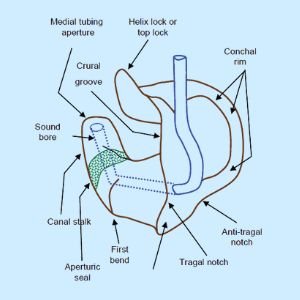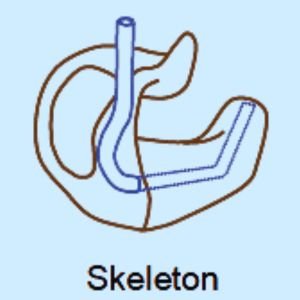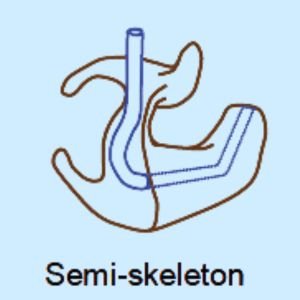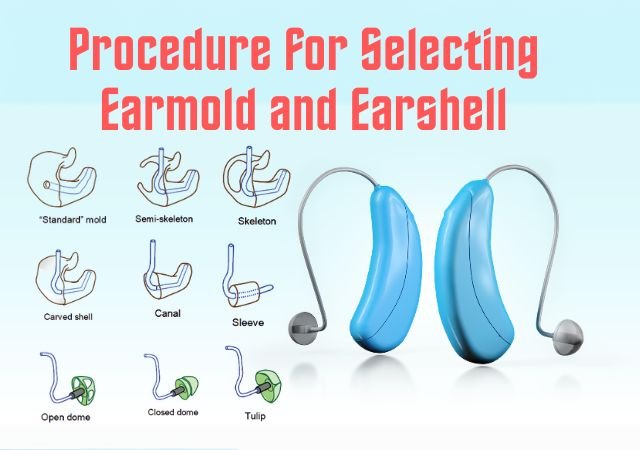 Types of Earmolds for Hearing Aid – Skeleton | Custom: The world of hearing aids is full of different choices. There are so many options made just for people with different levels of hearing loss. At the center of all variety, we find important parts called earmolds and earshells. These little pieces do a big job. They hold the hearing aids in place and help send amplified sounds right into the ear canal. Plus, they help manage how sound travels from the ear to outside air.
Types of Earmolds for Hearing Aid – Skeleton | Custom: The world of hearing aids is full of different choices. There are so many options made just for people with different levels of hearing loss. At the center of all variety, we find important parts called earmolds and earshells. These little pieces do a big job. They hold the hearing aids in place and help send amplified sounds right into the ear canal. Plus, they help manage how sound travels from the ear to outside air.
In this friendly article, we’re going to look at the outer ear’s parts, figure out what earmolds & earshells really mean, and talk about their special features—both the good stuff and what might not be so great.
While we explore earmolds, we’ll see many styles like skeleton earmolds, shell type earmolds, carved shell earmolds, and more. Each style has its own points to think about. These can change how well sounds are heard, how comfy they feel, and how securely they fit in the ear. Earmold styles have changed over time too! New ideas keep coming up in this area.
Next, let’s check out earshells. They include In-the-Ear (ITE), In-the-Canal (ITC), and Completely-in-the-Canal (CIC) devices. With all the tiny electronic parts packed inside the shell, we will also learn about Full Concha ITEs, Half Concha ITEs, Cymba Concha ITEs, ITCs, & CICs! This article is here to help anyone looking for comfort & effectiveness when using hearing aids—and for those who work with fittings too!
What is Earmolds and Earshell?

Anatomy of External Ear (Superior, Anterior and Lateral View)
Various styles of earmolds and shells occupy distinct areas within the concha and the canal. The components of these molds and shells correspond to specific parts of the ear they accommodate. Let’s examine the terminology associated with different ear parts, as well as the earmold or earshell representations depicted in Figures.
Three terms are employed in the process of fitting hearing aids:
- Earmold, utilized for Behind-the-Ear (BTE) devices.
- Earshell, is employed for In-the-Ear (ITE), In-the-Canal (ITC), or Completely-in-the-Canal (CIC) devices.
- Pre-molded canal fitting, used for thin-tube or Receiver-in-the-Ear (RITE) BTE devices.
A customized earmold or earshell is shaped to conform to the unique silhouettes of a person’s observance, securely holding the hail aid in place. Alternately,pre-molded conduit fittings, offered in colorful standard sizes and shapes, give an indispensable system for connecting the hail aid to the observance conduit.

Parts of an Earmold or Earshell
The ear fitting serves three primary purposes:
- Physically retaining,
- Transmitting amplified sound to the ear canal, and
- Managing the direct sound path from the ear canal to the external air.
Earmolds and earshells come in diverse physical styles, differing in the coverage of the concha and canal. These style variations impact the hearing aid’s appearance, acoustic performance, comfort, and the secure retention of the device.
Earmolds for Hearing Aid
In the world of hearing aids, choosing the right earmold can feel tricky. There are lots of options! variety can be helpful, but it can also make things a bit confusing for people looking for comfort & effectiveness. The landscape of earmold styles lacks standardized nomenclature, with names often reflecting characteristics, inventors, or original applications.
Since the American National Association of Earmold Laboratories got together in 1976 to set some names, a lot has changed. New styles popped up everywhere. There are many kinds of earmolds. You have your regular ones, but also cool new designs like the skeleton earmold, semi-skeleton earmold, shell type earmold, carved shell earmold, half shell type earmold, and canal type earmold. Each type comes with its own pros and cons for users. This way, you can see how they fit different hearing needs and personal choices.
These are shaped to fit the unique curves of your ear. When a mold of your ear canal is taken, it makes sure everything fits just right. So not only do they feel comfy, they also help improve sound quality and decrease annoying feedback noises.
In this article, we’ll talk about the many perks of custom earmolds. They really help meet different needs & likes for people using hearing aids. Whether it’s a perfect fit, more comfort, better sound quality, or changing with your hearing needs over time—custom earmolds make a big difference! They help boost how well people hear and keep them happy with their hearing aids!
Types of Earmolds for Hearing Aid
Describing various earmold styles poses a challenge due to the absence of standardized names. While the American National Association of Earmold Laboratories (NAEL) established some agreed-upon names in 1976, numerous new styles have emerged and been reintroduced since then. Certain earmolds are aptly named based on their characteristics (such as “skeleton”), while others bear the name of their inventor (like “Janssen”). Additionally, some earmolds are perplexingly named after their original application (e.g., CROS), even though they are more commonly used in different contexts.
Standard Earmold

The recipient mold, often referred to as a standard or regular mold (although it is infrequently utilized nowadays), is exclusively suitable for a body aid. A button receiver securely attaches to the ring on the mold’s surface. Alternatively, it can be employed for a BTE aid by affixing a plastic angle piece to the ring.
A section of tubing links the angle piece to the earhook of the hearing aid. Despite its convenience in tubing replacement, the recipient mold poses drawbacks (sound leakage, aesthetics, and potential reduction in high-frequency response) that outweigh its advantages for BTE use.
Skeleton Earmold
Skeleton earmolds comprise the ear canal section of the mold, inserted into the external ear canal of the child, and a retention ring that encircles the outer perimeter of the concha bowl of the ear. Typically, these molds are designed for children experiencing mild to moderate hearing loss, with occasional success in fitting children with moderately severe losses.

Advantages of Skeleton Earmold:
Usually, these earmolds are pretty comfy! The concha bowl of your ear stays open to air. This helps avoid that full feeling that some other molds can cause.
- They decrease the likelihood of moisture accumulation or irritation in the mold, thanks to the effective aeration of the outer ear.
- They can be crafted from various mold materials and are adaptable to most ear shapes and sizes. Suitable for use with mild to severe hearing loss.
Disadvantages of Skeleton Earmold:
They can cause feedback. Sometimes, they might even break when you’re putting them in or taking them out.
This is especially true if you have smaller ears. A thin or fine ring in the concha bowl can make the mold weak & less secure.
The design includes a canal and a thin frame around the ear bowl. It’s lightweight too! Plus, it has a subtle look that doesn’t stick out much at all.
So, while there are some challenges with different earmolds, there are many good options to choose from!

Semi-skeleton Earmold
In cases where complete retention is unnecessary, particularly when the ear canal has a convex shape, this style of ear mold is employed. Suitable for individuals experiencing mild to severe hearing impairments, this mold adapts to the unique contours of the ear.
Its design helps it fit snugly without needing to hold on tightly. This makes it comfy & effective for different hearing needs.
Shell Type Earmold
This earmold has a complete canal. It wraps around the ear bowl with a slim shell. it the helix, and sometimes it doesn’t! It’s mainly used for high-gain ear-level hearing aids, especially for those who have moderate to profound hearing loss. Kids really benefit from this type.
A lot of people like this earmold because it’s light and feels good to wear. It doesn’t get in the way! This earmold is popular because it works well for serious hearing issues while staying snug in your ear. So, if you need strong hearing help, this could really be a great choice!

Carved Shell Earmold
A Carved shell earmold comprises the ear canal segment and the concha bowl, completely enveloped in the ear mold material. To enhance both aesthetics and acoustic sealing, the concha bowl section of the mold is delicately shaped, creating a slightly concave outer surface. These molds are suitable for fitting to any child.
Advantages of Carved Shell Earmold:
You can make these ear molds from many different materials.
They can fit all kinds of ear shapes & sizes! Many parents like them for their little kids because they sit snugly in the ear.
Plus, they help block out distracting sounds really well.
Fitting them is usually a piece of cake for young kids.
Now, let’s talk about carved shell molds. There aren’t any big problems with using them.
Half Shell type Earmold
When you don’t need a super tight fit or if the shape of the ear bowl is rounded, this type works great! It’s good for people with mild to severe hearing loss. These molds help when a snug fit isn’t critical. So, it gives a comfy choice for different hearing needs.

Canal type Earmold
It features a complete canal and a slender shell enveloping the ear bowl, with or without the helix. This type is employed in cases of moderate to profound hearing loss when fitting very high-gain ear-level hearing aids. Particularly suitable for children, it stands out as one of the most commonly utilized earmold types. Its lightweight design enhances comfort during use.
Other Earmolds

Pre-molded canal fitting: Open, Closed and Tulip Earmolds
The Figure illustrates the commonly utilized fittings, which include pre-molded, dome-shaped canal fittings and thin sound-bore tubing. These fittings feature a soft, flexible flange or flanges and are available in various diameters and tubing lengths.

There are essentially two styles: the open dome, with holes in the flange designed to keep the canal as open as possible, and the closed dome, with no holes intended to seal the canal completely. Due to the fitting being entirely enclosed within the ear canal, especially when paired with thin tubing and small BTE hearing aids, both the open and closed dome styles, along with the very similar tulip style, contribute to a discreet overall appearance.
The same designs apply to RITE or RIC hearing aids, with the central part of the dome housing the receiver encased in plastic, resulting in a sound bore of only 1 or 2 mm. For RITE hearing aids, the thin tube from the device is replaced by an equally thin electrical connection to the receiver, maintaining an inconspicuous look.
A notable advantage of dome and tulip fittings is that they eliminate the need for an ear impression, facilitating same-day fitting.
It is crucial to select the correct dome size and tubing length:
1. If the dome is too large, discomfort may occur.
2. If too small, the fitting may fall out or cause itching as it moves.
3. Inappropriate tubing length can lead to discomfort behind the ear or within the ear canal.
Open dome fittings serve the same acoustic function as the sleeve mold and vented hollow canal mold, largely surpassing them in popularity, although the latter two designs may still find relevance in certain cases.
Custom Earmolds for Hearing Aids
Custom earmolds for hearing aids are individually crafted earpieces that are designed to fit the unique shape of a person’s ear. These earmolds provide a comfortable and secure fit for hearing aids, ensuring optimal performance and sound quality. Here are some key points about custom earmolds for hearing aids:
Personalized Fit
Custom earmolds are created based on an impression of the individual’s ear canal. This ensures a snug and personalized fit, which is essential for comfort and effective sound transmission.
Enhanced Comfort
The customized fit of earmolds reduces discomfort and irritation often associated with generic, one-size-fits-all solutions. This is particularly important for individuals who wear hearing aids for extended periods.
Improved Sound Quality
The precision fit of custom earmolds helps to seal the ear canal, preventing sound leakage and improving the efficiency of the hearing aid. This can lead to better sound quality and clarity.
Reduced Feedback
Custom earmolds can help minimize issues such as feedback or whistling that may occur with poorly fitting hearing aids. A proper seal prevents sound from escaping and causing interference.
Various Materials and Styles
Earmolds can be crafted from different materials to cater to individual preferences and sensitivities. Additionally, various styles are available, including full-shell, half-shell, and canal earmolds, depending on the user’s needs.
Color and Aesthetics
Users can choose the color and appearance of their custom earmolds. Some may prefer a discreet and flesh-toned design, while others may opt for vibrant colors or patterns.
Professional Impression
The process of obtaining custom earmolds involves taking a professional impression of the ear canal. This is typically done by an audiologist or hearing care professional to ensure accuracy.
Maintenance and Cleaning
Custom earmolds require regular cleaning to prevent wax buildup and maintain optimal performance. Audiologists often provide guidance on proper care to extend the lifespan of the earmolds.
Adaptability to Hearing Changes
As hearing needs change over time, custom earmolds can be adjusted or replaced to accommodate these changes, ensuring ongoing comfort and effectiveness.
Overall, custom earmolds play a crucial role in maximizing the benefits of hearing aids, offering a tailored solution that addresses the specific needs and comfort of the individual wearer.
Earshells for Hearing Aid
Explore the diverse world of hearing aid shells in this informative article, delving into the intricacies of In-The-Ear (ITE), In-The-Canal (ITC), and Completely-In-Canal (CIC) devices. With the electronic components snugly housed within the shell, options for alternative designs are examined within each category. Uncover the distinctions between Full Concha ITEs, Half Concha ITEs, and Cymba Concha ITEs, each tailored to unique anatomical contours. Discover the subtleties of mini-canal ITCs, extending along the posterior medial wall of the tragus, and gain insights into the axial and lateral perspectives crucial for understanding these innovative hearing aid solutions.
Types of Earshells for Hearing Aid
Because the electronics of the hearing aid are inside the shell for an ITE, ITC, or CIC hearing aid, there are fewer possibilities for alternative shell styles within each of these classes of hearing aids.
- Full Concha: ITE hearing aids that extend above the crus-helias are classified as Full Concha ITEs
- Half Concha: Those that are fully contained below the crus-helias are referred to as Half Concha ITEs, and
- Cymba Concha: Those that fit entirely above the crus-Helias could be called Cymba Concha ITEs.
- ITC: That extend only part of the way along the posteriormedial wall of the tragus are sometimes referred to as mini-canal hearing aids
- CIC
Hearing aids categorized as mini-canal ITCs are designed to extend only a portion of the way along the posterior medial wall of the tragus. These devices, known as mini-canal hearing aids, can be considered as low-profile in-the-canal (ITC) options. To understand the differences between in-the-ear (ITE) aids, low-profile ITEs, ITCs, completely-in-canal (CICs), and deeply seated (long-wear) CICs, the most effective perspective is an axial section through the ear, illustrated in the figure. Although they are too new to have developed a terminology. These differences are best seen from a lateral view, as shown in Figure.

Lateral view of different ITE, ITC, and CIC Earshells

Axial view of different ITE, ITC, and CIC Earshells
Earmold Materials
An additional crucial factor to contemplate is the earmold’s composition material. Typically, softer materials like silicone and vinyl are employed for hearing losses surpassing 75 dB HL. The table delineates the key earmold materials and their respective performance benefits.
| Name | Characteristics | Advantages |
| Acrylic | Hard |
|
| Silicone | Semi-soft |
|
| Soft Silicone | Very-soft |
|
Procedure for Selecting Earmold and Earshell
Structured protocols exist for assessing the optimal openness of an earmold for an individual hearing aid user, as detailed in the ‘Procedure for Selecting Earmold and Earshell‘ article. However, the process becomes less straightforward when faced with choosing between molds that primarily vary in visual aesthetics, durability, and retention capabilities. Determining the most suitable earmold in such cases lacks a clear, systematic approach.
Ear Impression Techniques for Earmolds and Earshells
While this article begins by discussing earmold and earshell varieties, it’s essential to emphasize that the creation of earmolds or earshells necessitates the initial step of obtaining an impression. Therefore, please explore the content of the article titled “Ear Impression Techniques for Earmolds and Earshells,” which outlines methods and materials for producing accurate impressions.
Conclusion: Types of Earmolds for Hearing Aid – Skeleton | Custom
To sum it up the world of earmolds & earshells for hearing aids is full of variety. There are many choices to meet the special needs of people with different levels of hearing loss. You can find traditional earmolds, plus cool new designs like skeleton earmolds, shell types, carved shells, and more. Each type has its own perks and things to think about. This article points out how custom fits are. They not only feel good but also improve sound quality & cut down on feedback problems. It talks about different types of earmolds and how they work with specific hearing aid devices—also what people like.
Plus, there’s a look at earshells! These include In-The-Ear (ITE), In-The-Canal (ITC), & Completely-In-Canal (CIC) devices. You’ll find details about Full Concha ITEs, Half Concha ITEs, Cymba Concha ITEs alongside ITCs & CICs. Understanding their anatomical features helps choose the right one.
The article wraps up by mentioning the tricky parts of choosing earmolds based on looks, strength, and how well they stay in place. Readers are encouraged to check out “Ear Impression Techniques for Earmolds and Earshells” for more details.
In all, this friendly guide helps people learn more and make smart choices about the right hearing aid solutions for them.
FAQs about Types of Earmolds for Hearing Aid – Skeleton | Custom
1. What is an earmold?
An earmold is a custom-designed earpiece that conforms to the unique contours of an individual’s ear. It serves as an integral component in hearing aid devices, providing a secure fit, transmitting amplified sound to the ear canal, and managing the direct sound path from the ear canal to the external air. Earmolds are commonly used for Behind-the-Ear (BTE) hearing aids.
2. How do I change earmold tubing?
To change earmold tubing, follow these steps:
- Remove the existing tubing by gently pulling it away from the earmold and hearing aid.
- Cut a new piece of tubing to the appropriate length.
- Insert one end of the tubing into the earmold, ensuring a snug fit.
- Connect the other end of the tubing to the earhook of the hearing aid.
- Ensure proper alignment and secure attachment to prevent sound leakage and maintain optimal hearing aid performance.
3. How do I clean earmolds for hearing aids?
To clean earmolds for hearing aids:
- Use a mild soap and water solution to clean the earmold surface.
- Gently scrub with a soft brush or cloth to remove wax and debris.
- Avoid using harsh chemicals or alcohol, as they may damage the earmold material.
- Ensure thorough drying before reinserting the earmold into the ear.
- Regular cleaning helps prevent wax buildup, ensures hygiene, and maintains the effectiveness of the hearing aid.
4. How are earmolds for hearing aids made?
Earmolds for hearing aids are made through a personalized process:
- A professional takes an impression of the individual’s ear canal.
- The impression is used to create a customized earmold that fits the unique contours of the ear.
- Materials such as silicone or acrylic may be used to craft the earmold.
- The final product ensures a personalized fit, enhanced comfort, and improved sound quality.
5. How do I retube an earmold?
To retube an earmold, follow these steps:
- Remove the existing tubing carefully to avoid damaging the earmold.
- Clean the earmold surface and earhook thoroughly.
- Cut a new piece of tubing to the appropriate length.
- Insert one end of the tubing into the earmold and ensure a secure fit.
- Connect the other end of the tubing to the earhook of the hearing aid.
- Confirm proper alignment and attachment for optimal hearing aid performance.
References:
- Hearing Aids – Harvey Dillon (Book)
- Essentials of Audiology – Stanley A. Gelfand, PhD (Book)







0 Comments